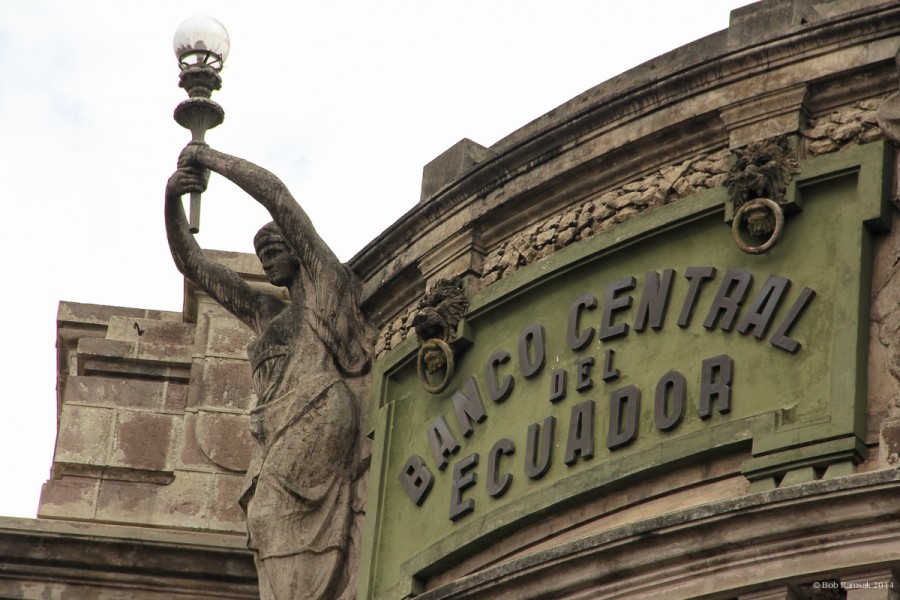Last week, the Legislative Administration Council (CAL) of the Assembly sent the bill for the Defense of Dollarization back to the President because it had constitutional and legal errors. The corrected version of the text will be back in the hands of the Assembly this week.
El Universo newspaper interviewed Verónica Artola, the manager of the Central Bank of Ecuador (BCE), to get an understanding of exactly what the new law will do. Artola is an economist from the Pontificia Universidad Católica del Ecuador, with a master’s degree in Applied Economics from the Autonomous University of Barcelona. She was Undersecretary of Planning for Good Living and Undersecretary of Monitoring and Evaluation in the ex-Senplades and also the Secretary of the National Planning Council.
Here is a summary of that interview:
How does the reform seek to strengthen dollarization?
Important advances have been made in the last four years, but by technical decision from the bank and the President of the Republic. What if there is no such decision in the future? It is necessary not to go backwards in this task and, therefore, the reform has three pillars.
Which are?
Make autonomous and technical decisions for resource management. This would be achieved by creating a Board of the ECB. The second is to return to the Central Bank the role of advisor and reliable data generator. And third, have financial and administrative autonomy.
This is not the first time that the ECB has been requested autonomy. What makes you think now that it will be approved?
We believe that in this new text, certain things that were sent in the 2019 Law were corrected. The request was collected, for example, that the members of the Central Bank’s Board of Directors should not be appointed by the President but by the Assembly, from a list of three of the Executive. I hope that the reform debate is technical, without lies.
It has been said that they want to privatize the ECB and that the Board of Directors will be in the hands of private banks. Is that true?
It is a misconception, to privatize is to sell and at no time does the project say that. They have been very adept at putting in this privatization scare. What is sought is an autonomous Directory, with political and economic powers. To guarantee this, requirements have been established and conflicts of interest are regulated.
Why is currency reform necessary?
To sustain dollarization; it maintains a solid international reserve. Without that, we can go into default. That would mean we would stop paying foreign debt or stop importing goods and services, fuels or stop giving coins and bills to the economy. In addition, the reserves allow us to secure the resources of the citizens, social security, GAD.
In what percentage do the reserves cover the bank’s obligations to depositors, social security, and GADs?
In the years when the Central began to invest heavily in the Ministry of Finance, the reserve began to deteriorate. In 2009 it covered almost 70% of the liabilities (including obligations with the bank) with its reserve, but in 2017, when the largest amount of investment was made, it had only 28% coverage. We need the reserves to be liquid to immediately cover the resources of third parties to face any emergency. Now we have public bank stocks, Finance bonds and public bank bonds for $ 6.5 billion, which we cannot make liquid if we need to.
Did this situation create problems for the Bank?
Yes. For example, last April, in a single month, we were sued for $1.5 billion from the vault and at that time the reserve was only $1.8 billion, with which we had only $300 million to pay foreign debt, imports, fuel, and they were not enough. We needed from $2.5 billion to 3 billion, so we had to look for urgent credits. Now the banks have a very large reserve requirement, they are overdrawn by more than $4 billion. Our reserves are around $6.5 billion, so it is covered without problem if they ask for their resources. For this reason, it is important to have these resources in a liquid way and to have strong reserves.
When will 100% coverage of people’s deposits be reached?
It has been said that we are taking care of the resources of the banks and it is not that. The resources that the ECB belongs to the depositors. The first thing to cover are those third-party resources, that includes coins in circulation, deposits from private banks, cooperatives, public banks that have people’s deposits and the titles of the ECB. According to the analysis and payment schedule that the Ministry of Finance must make, this could be covered in 2026.
How do you see the fact that it is said that there are $6.5 billion of the reserve earning 0% interest, when that could be in the country generating reactivation?
It is confused what the ECB is for in an economy like Ecuador’s. The Central cannot issue currency, its function is to safeguard the money that citizens have in financial institutions against any risk. Yes, you can do monetary policy, but technical. To speak demagogically, that they are going to take $1 billion from reserves or that $6.5 billion may be put into the economy, is irresponsible and a risky proposition. Let’s see how far the ECB sheets go without putting dollarization at risk. And, in any case, the injection that is for reactivation and not public spending.


0 Comments